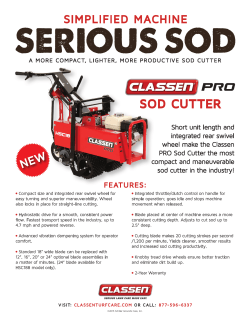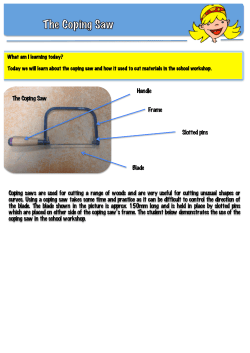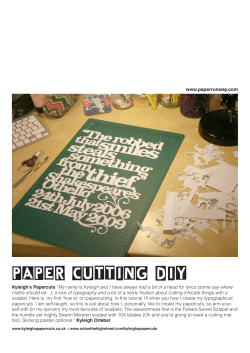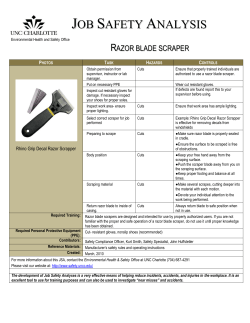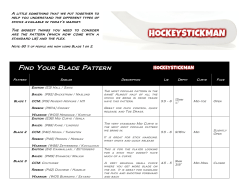
#P665 - Use 1 3/8” clock inserts. 2 designs per set.
#P665 - Boats Mini-Clocks Use 1 3/8” clock inserts. 2 designs per set. GENERAL SCROLLSAW TIPS & TECHNIQUES The following scrollsaw tips and techniques are intended to get you started and on your way to scrollsaw success. Not only will you find these techniques helpful in completing the this project, you will also find that they can be applied to many other scrollsaw projects as well. HARDWOODS VS PLYWOODS Selecting the type of material you will use is very important for the final outcome of your project. This project has been designed so that hardwoods, plywoods, or a combination can be used to create your work of art. Hardwoods have their advantages as well as their disadvantages. They come in a variety of species, colors and grain patterns, yet they are more time consuming requiring more sanding, are more likely to warp and are more expensive to use. Plywoods, on the other hand, are less expensive, require less sanding, and come in a variety of standard thicknesses. They also are less likely to develop cracks or warp. We do, however, recommend that you use a top grade plywood without voids, such as the Baltic and Finnish birches. SANDING For most projects, it is best to sand the work piece prior to applying the paper pattern and cutting the design. Once you’ve cut the design, and removed the paper pattern, it may be necessary to lightly sand any glue residue remaining, along with any “fuzz” on the bottom side. BLADE SELECTION There are many opinions pertaining to which blade to use with which type and thickness of material, as well as, with how intricate the design in the project is. The more time Material Thickness Blade Size Recommended you put into scrolling, the more your choice of which blade to 1/16” - 1/4” #2/0 or #2 use will become personal preference. For the beginning 1/4” - 1/2” #5 or #7 scroller we make the following recommendations to get 1/2” - 3/4” or thicker #7 or #9 you started: USING THE PATTERNS Downloadable patterns give you the advantage of printing the patterns on your own printer at your own convenience. Be sure to download all of the file and save it to a disk or your harddrive according to your computer software’s instructions. Once you have printed the number of pattern pieces that you will need to complete your projects, you are ready to apply the pattern to your work pieces. Apply the repositionable spray adhesive as directed in the next section. If your project requires piecing 2 or more sheets of paper together to make the full-size pattern piece, simply follow the instructions below for accurate alignment. Pattern overlap line Frame & Back Stock: 1/8” - 1/4”, cut 1 each Left pattern piece. Ruler Cut on solid line for Frame only. Pattern overlap line Craft knife Clear tape Cut on dashed line for Back Step 2 Step 1 Using a straightedge and a craft knife, cut on the dashed “Pattern Overlap Lines” to remove the excess paper. Next, align the sections and secure together with clear tape. Now, apply the repositionable spray adhesive to the backside of the paper pattern as instructed in the next section. REPOSITIONABLE SPRAY ADHESIVE Using a repositionable spray adhesive is the easiest and quickest way to transfer a pattern to your work piece after photo copying it. In a well ventilated area, lightly spray the backside of the paper pattern. Allow it to dry only until tacky - approximately 20 - 30 seconds. Then apply it to the work piece, smoothing any wrinkles if necessary. Two common problems that sometimes occur when using repositionable spray adhesive for the first time is applying the right amount onto the back of the pattern. Spraying too little may result in the pattern lifting off of the project before you have finished cutting. If this occurs, clear scotch tape can be used to secure the pattern back into position. On the other hand, spraying too much will make it difficult to remove the pattern, If this occurs, simply use a hand held hair dryer to heat the glue, which will loosen the pattern allowing it to be easily removed. DRILLING STARTER HOLES When drilling starter holes it is best to drill close to a corner, rather than in the middle of the waste areas, as it will take less time for the blade to reach the pattern line. STACK CUTTING Stack cutting is fairly simple to do and can save you a lot of time when you have 2 or more identical pieces to cut for a project. If you are fairly new to scrollsawing and stack cutting, we recommend cutting no more than a total thickness of 1/2” for best results. On projects with fairly simple shapes to cut out, 2 or 3 layers could be held together by double-sided tape, or by using spray glue on paper to sandwich between the work pieces. On more intricate projects we suggest using #18 wire nails or brads slightly longer than the total thickness of the stack you are cutting. Tack the nails into the waste areas you will cut out, along with a few around the outside of the project. If the nail has gone through the bottom of the work piece, use a hammer to tap it flush, or use coarse sandpaper to sand the points flush with the bottom of the work piece. If you are stack cutting hardwoods, do not tack the nail too close to the pattern line or it may cause the wood to split. Another option would be to predrill for the nails with a slightly smaller drill bit so the nail will fit snugly and hold the layers together securely. SAWING THIN WOODS Occasionally you may find it difficult to control your workpiece when cutting in thin hardwoods or plywoods. The following suggestions should help to eliminate or reduce this problem. 1. If you have a variable speed saw, reduce the speed to 1/2 to 3/4 of high speed. 2. If you do not have a variable speed saw, it will help to stack cut 2 or more layers of your material to keep better control of the workpiece. 3. For cutting any thickness of material it is very beneficial to keep at least one hand, if not both, partially touching the table with your fingers for better control. 4. Using a smaller blade with more teeth per inch helps to slow down how fast the blade is cutting. But keep in mind that if the blade is leaving burn marks you will need to slow the speed down or use a blade with less teeth per inch. VEINING Veining is a simple technique that will bring a lifelike appearance to your project. The veins of a leaf or the folds of clothing will look more realistic when this technique is incorporated. To vein, simply saw all solid black lines as indicated on the pattern. Some areas of the pattern you will be able to vein by sawing inward from the outside edge, while in other areas you will need to drill a tiny starter hole for the blade. AUXILIARY TABLE Most scrollsaws on the market today have an opening in the table around the blade that is much larger than what you really need. This often causes small and delicate fretwork to break off on the downward stroke of the blade. An easy solution is to add a wooden auxiliary table to the top of the metal table on your saw. To make an auxiliary table, choose a piece of 1/4” - 3/8” plywood similar to the size of your current saw’s table. If you choose, you can cut this plywood to the same shape as the metal table on your saw, or any shape or size you prefer. However, we do recommend that you make the table larger than what you think you will need for the size of the projects you will make in the future. Next, set the auxiliary table on top of the metal table. From the underside of the metal table, use a pencil to mark the location where the blade will feed through. Then turn the auxiliary table over and drill a 1/16” - 1/8” diameter hole, or slightly larger than the blade you will be using. Finally, apply a couple of strips of double-sided carpet tape to the metal table on each side of the blade. Then, firmly press the auxiliary table onto the double-sided carpet tape, making sure that the blade is centered in the hole. FINISHING TECHNIQUES If you’ve made your project from hardwood, we recommend dipping your project in a dishpan type of container that contains a penetrating oil such as Watco, Tung, or others. After dipping, allow the excess oil to drain back into the pan and then follow the manufacturer’s instructions. If you have chosen to use plywood, such as Baltic Birch, you can use any of the wide variety of wood stains available on the market. We do, however, recommend sanding the surface thoroughly, in order for the plywood to accept the stain more evenly. As a final finish step, we highly recommend using a clear varathane type spray for a protective coating. #P665 - Steamer Desk Clock 12 Description item Qty 3 9 6 C A Figure Figure Base C B A B C 1 2 1 1/4”T x 4 5/8”W x 10”L 1/8”T x 1 1/2”W x 9”L 1/4”T x 4 5/8”W x 10 7/8”L #P665 - Steamer Desk Clock #P665 - Assembly Instructions 1. Select your material from a variety of hardwoods or solid core plywood. 2. Measure each pattern piece and cut the work pieces to size accordingly. Sand as necessary. 3. Make all pattern pieces by adhering the paper patterns to the work pieces with a repositionable spray adhesive. Cut the outer shapes and any interior designs. And drill where indicated. 4. Remove all paper patterns. Sand where needed. The edges can be rounded by sanding. 5. Assemble by securing the pieces with glue where needed. Finish as desired. Insert the clock movement or photo frame. A 12 3 9 6 B Sailboat Desk Clock #P665 - Sailboat Desk Clock Description item Qty #P665 Back Base A B 1 1 Size Size 1/4”T x 7”W x 7 1/2”L 1/4”T x 3 1/4”W x 8 5/8”L #P665 Stock: 1/4” Figure (A) for clock insert or photo frame Bore 1 3/8” diameter hole #P665 Stock: 1/4” Base (C) Figure (A) Adjust slots, if necessary, for thickness of material used. Figure (B) Figure (B) Stock: 1/8”, cut 2 Figure (B) Figure (A) Back (A) Stock: 1/4” Bore 1 3/8” diameter hole for clock or photo frame insert. #P665 #P665 Stock: 1/4” Base (B) Adjust slot, if necessary, for thickness of material used.
© Copyright 2025


